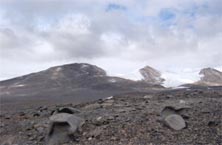Another walk, slightly longer
December 2nd, 2001
"I don't care how long you go for, just as long as you take a radio and log the time you go and the time you expect to be back. If you're not back by the time you say, we're going to send out a search team."
- Rae Spain, Lake Hoare camp manager
Here, distances are deceiving. They say it's because the air is clear so you're seeing all the way to the horizon. That little mountain peak right over there takes two hours of walking to reach. That glacier that seems touchable ends in a scarp 70 feet high. Those little dots at the base are boulders 15' tall. Here the meaning of relative time takes meaning. You're either walking forever or for no time at all. From the mountain top, the glacier face that seemed insurmountable seems flush with the ground. You see camp below you, tiny flecks of color amid the brown and white.


The frozen lake at the foot of the Canada glacier looks blue. This is not the reflection of the sky as you might suspect, but something deep and iridescent. Wherever two pieces of white ice come together there is blue at the junction. In these pictures the blue is flat glaze ice. Up north we'd call it black ice. Here it's blue.


Across the lake from camp is the Andrews Ridge. Were it not for the fact the face is a scree of glacier detritus this would be a strenuous, mountain bikable peak. It's about as high as the Sierra Azul range near my home, about 1500 feet. The difference is the surface is a continuous layer of pebbles, rocks, and boulders. Soft dirt and permafrost lies under the rocks. At the mountain top are the ventifact rocks. Larger stones are scoured by the action of wind-borne dirt and pebbles. Their surfaces are pitted and smooth. Some of the stones are worn through completely.


From this vantage point on the top of the ridge you could see all the way to the Ross Sea. In the distance is Lake Fryxell. Not visible in this shot are tabular bergs off in the distance on the sliver of white between the mountains in the right center of the picture.. The bergs are trapped in the sea ice. We passed them in the helicopter on the way over.


